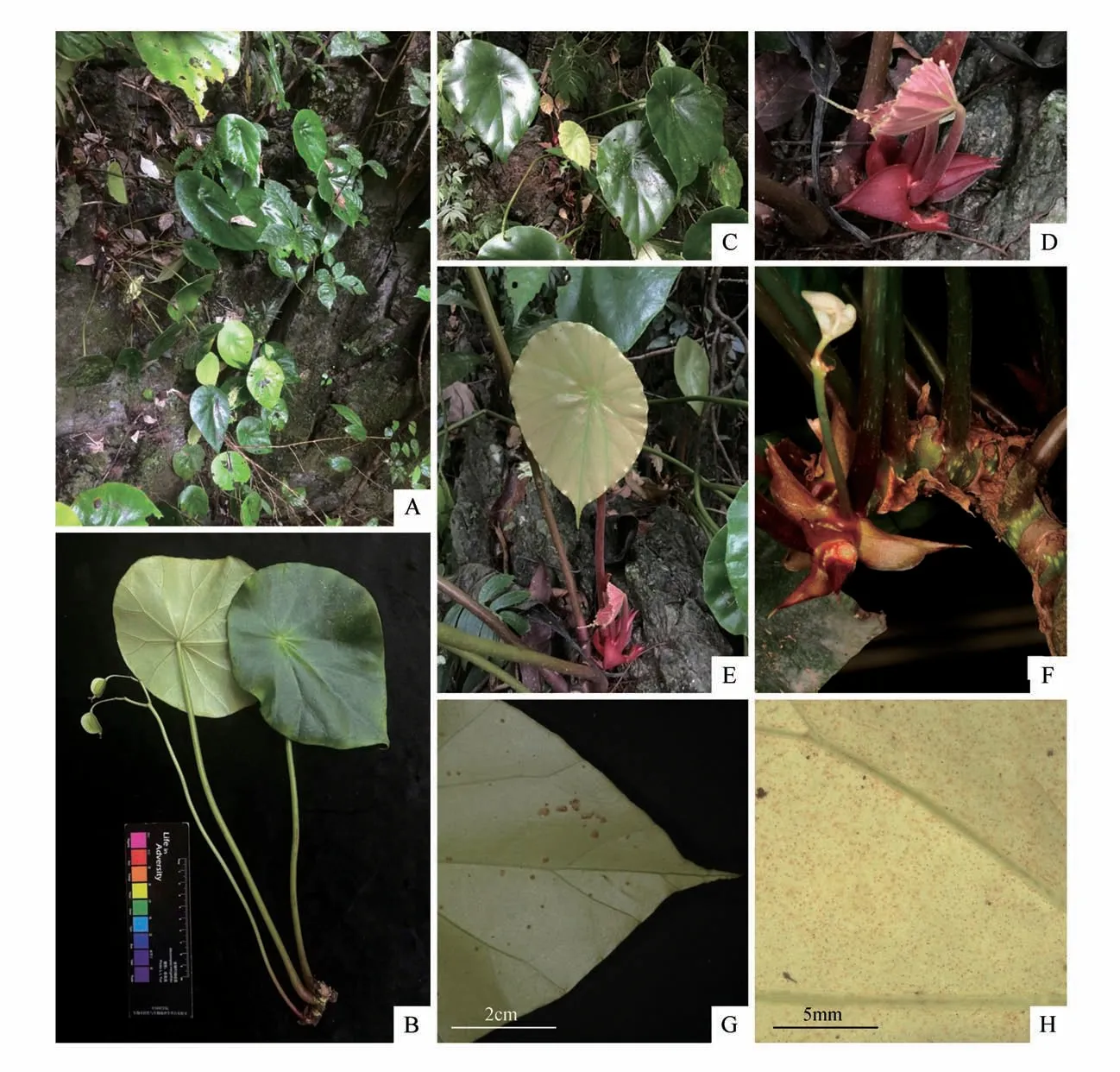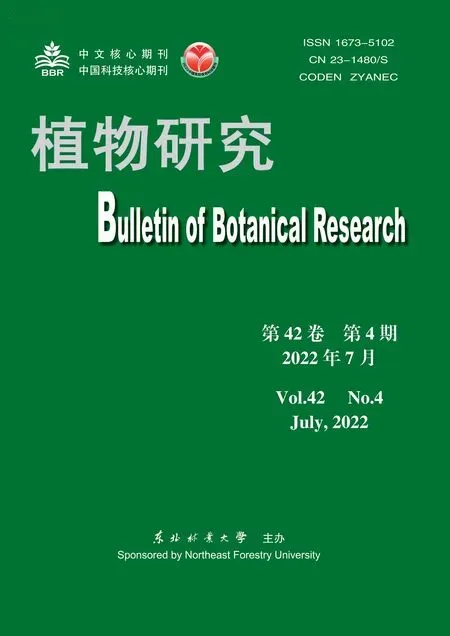合柱秋海棠
——越南北部喀斯特地区秋海棠科盾叶一新种
陈文红 李景秀 NGUYEN Quang-Hieu NGUYEN Sinh-Khang PHAM Van-The 范长丽 向建英 税玉民*
(1. 中国科学院东亚植物多样性与生物地理学重点实验室,中国科学院昆明植物研究所,中国·昆明 650201;2. 昆明植物园,中国科学院昆明植物研究所,中国·昆明 650201;3. 植物保育中心,越南科学技术联盟,越南·河内;4. 生态与生物资源研究所,越南科学技术部,越南·河内;5. 环境管理研究室,高级科技研究所,孙德盛大学,越南·胡志明市;6. 技术系,孙德盛大学技术系,越南·胡志明市;7. 云南生物多样性研究院,西南林业大学,中国·昆明 650224;8. 云南省喀斯特地区生物多样性保护研究会,中国·昆明 650201;9. 滇东南热带山地生态系统定位研究站,中国·屏边 661200)
The species ofL. with peltate leaves are common worldwide.In Africa,sect.A.DC. is completely dominated by peltate leaves and with about 46 species in West and West-Central Tropical Africa. In America,sect.A. DC. is mostly dominated by peltate leaves and with 38 species in the Andean regions. In Asia,the pelate-leaved species are randomly in many sections,such asH.L. Li insect.Y.M. Shui & W.H. Chen,A. DC. insubg.(Klotzsch.)C.B. Clarke,and so on. However,sect.Irmsch. is rich in species with peltate leaves in China and Vietnam.
sect.Irmsch. is endemic to the karst regions in South China and North Viet‑nam and represents rich diversity of peltate-leaved species. Up to now,there are 16 peltate-leaved taxa of the total 88 species of the above section,viz.Y.M.Shui,W.H. Chen & H.Q.Nguy‑en,Y.M.Shui & W.H.Chen,H.Lévl.,D.R.Liang & X.X.Chen,Yan Liu,S.M.Ku & C.I. Peng,Hance,S.M.Ku & Yan Liu,H.Q.Nguyen,C.I.Peng&S.M.Ku,Y.M.Shui& W.H.ChenC.Y.Wu,C.I.Peng,Y.H.Qin & C.W.Lin,Y.Wan & B.N.Chang,var.Y.M.Shui& W.H.ChenY.M.Shui& W.H.Chen,T. T. Yü. Among them,andare widely distributed at higher elevation and the lower elevation,respective‑ly. Based on the previous data(CVH,https://www.cvh.ac.cn/index.php;GBIF,https://www.gbif.org/),was distributed from Hunan and Chongqing of China to Thanh Hoa and Son La of Northwest Vietnam. So far,have constituted a spe‑cies complex for their almost glabrous habit,peltate leaves and karst habitat.
Thecomplex is gradually rec‑ognized with the integrated surveys and observation in botanic gardens. Before 2006,there were two spe‑cies accepted within the complex,e.g.and. After 2016,there were three new species,e.g.and. Recently,the further field survey and specimen examination in herbaria reveal that there is an additional potential new species in the complex. The unknown species have been identified asin the herbaria worldwide,such as HN,K,LE,MO and P. However,the observa‑tion of living plants in botanic gardens indicates that it is a distinct species because of its combined styles and lunate stigmas. Furthermore,this species is nar‑rowly distributed in Hoa Binh and Thanh Hoa prov‑inces of Vietnam,the southernmost regions of the complex. Based on studying genetic diversity of the complex(unpublished),the unknown species is close toin Southwest Guangxi. Here,we name the unknown species asfor its half combination of styles and describe it in the fol‑lowing.
Key to the peltate-leaved species of sect. Irmsch. in Begoniaceae
1.Fruits berry ……………………………………………………………………………………………………………………… 2
1.Fruits dehiscent ………………………………………………………………………………………………………………… 3
2.Petiole glabrous ……………………………………………………………………………………………………
2.Petiole pilosous …………………………………………………………………………………………………………
3.Capsules narrowly oblong or ovate excluding wings ……………………………………………………………………………… 4
3.Capsules ovate excluding wings ………………………………………………………………………………………………… 8
4.Petals acute at apex ……………………………………………………………………………………………………………… 5
4.Petals round or obtuse at apex …………………………………………………………………………………………………… 6
5.Stems creepingleaves blades narrowly ovatered on the adaxial surfacetepals 2……………………………………
5.Stems erect;leaves blades ovate,red on the adaxial surface;tepals 4 ……………………………………………………
6.Petioles inflate on the base ……………………………………………………………………………………………………… 7
6.Petioles slightly inflate on the base …………………………………………………………………………………
7.Style combined to the middle ………………………………………………………………………………,sp.nov.
7.Style combined at the base …………………………………………………………………………………………
8 Leave blades glabrous…………………………………………………………………………………………………
8 Leave blades more and less pilosous …………………………………………………………………………………………… 9
9 Leave blades green……………………………………………………………………………………………………………… 10
9 Leaves blades diverse in color ………………………………………………………………………………………………… 12
10 Leaves petiole sparely villous …………………………………………………………………………………
10 Leaves petiole dense pubescent ……………………………………………………………………………………………… 11
11 Leave blades less than 9 cm long………………………………………………………………………………………
11 Leaves blades more than 9 cm long ………………………………………………………………………………
12 Leave blades are averagely dotted by white patches …………………………………………………………
12 Leave blades are radiately dotted by white patches along main nerves………………………………………………………… 13
13 Leave blades densely covered by setae on the adaxial surfaces ……………………………………………………………… 14
13 Leave blades sparely covered by setae on both sides ………………………………………………………………………… 15
14 Rhizomes gracilis ………………………………………………………………………………………………………
14 Rhizomes robust ………………………………………………………………………………………………
15 Petals sparely pilosous on the adaxial surface ………………………………………………var.
15 Petals densely pilosous on the adaxial surface ………………………………………………………………………
Taxonomic treatment
Y.M.Shui & W.H.Chen,sp.nov.(Fig.1-3)

Fig.1 Vegetative morphology of B.holostyla Y.M.Shui&W.H.Chen,sp.nov.
The new species is similar toin its peltate leaves and black dots on fruits,but differs in its styles combined to a half(combined at base),lunate stigma without a spiraled band2-cleft in a spiraled band).
Herbs rhizomatous,20-35 cm tall.Rhizomes ca.1 cm in diam. Stipules ovate-triangular,apex acute,1.0-1.2 cm long,0.6-0.7 cm wide at base,glabrous.Petioles erect from rhizome,26-31 cm long,0.3-0.4 cm in diam.,nearly glabrous and with sparse scale slips,slightly swollen at base. Leaf blade pel‑tate,asymmetric,ovate to broadly ovate,green,slightly leathery,(16-18)cm ×(13-14)cm,base rounded,margin entire,apex acuminate to caudate,adaxially green,glabrous,abaxially green,nearly glabrous and with sparse scale slips,venation radi‑al,ca. 9 primary veins,secondary veins obscure. In‑florescence dichasial and axillary,cymes ca. 36 cm long;peduncles ca. 30 cm long,0.3-0.4 cm in di‑am.,nearly glabrous and with sparse scale slips;bracts caducous;bracteoles triangular,ca. 0.6 cm long,ca. 0.3 cm wide at base,glabrous,apex actue.Staminate flower:pedicel 1.6-1.8 cm long,gla‑brous;tepals 4,white to pinkish,glabrous,outer 2,orbicular,ca. 1.8 cm in diam.,base truncate,margin entire,apex round or obtuse;inner 2,ob‑long to oblanceolate,(1.0-1.1)cm ×(0.4-0.5)cm,truncate,margin entire,apex obtuse;androecium actinomorphic,androphore short or absent,stamens ca. 55,filaments base-fused,0.8-1.2 mm long;an‑thers yellow,oblong,ca. 0.6 mm long,apex round,basifixed,with 2 slits. Pistillate flower:pedicel ca.1.1 cm long,glabrous;tepals 4,white to pinkish,glabrous,outer 2,broadly ovate,(1.5-1.6)cm ×(1.8-1.9)cm,base truncate,margin entire,apex round;inner 1,oblanceolate,ca. 1.0 cm × 0.5 cm,base truncate,margin entire,apex obtuse;styles 3,ca. 4 mm long,with a column connate at base ca. 2 mm long;stigmas bilobed,spirally twisted;ovary greenish,oblong,ca. 1.3 cm × 0.5 cm(wings ex‑cluded);placentation axile,3-loculed,2 branches per locule;wings 3,dorsal wing ca. 1.2 cm × 0.2 cm,upper narrowly and base widely,lateral wings ca. 1.3 cm × 0.1 cm. Capsule nodding,oblong,ca.1.9 cm×0.7 cm(wings excluded),with pedicel 2.2-2.6 cm long,with unequal 3 wings;dorsal wing ca.1.7 cm long and ca. 0.6 cm wide(at base),lateral wings narrowly,ca. 0.4 cm long and ca. 2.0 cm wide(at apex). Seeds oblong,ca. 0.6 mm long. Flowering from June to August,fruiting from July to September in green house.
Distribution and habitat :Vietnam(Hoa Binh,Son La and Thanh Hoa provinces). It grows on the surfaces of rocks in karst regions with 550-700 m el‑evation.
Examined specimens: VIETNAM:Hoa Binh Prov.,without detailed locality,introduced at Kun‑ming Botanic Garden by Mrs Xiang Jianying in 2003,pressed as specimens in 16 Sep.,2021,-(Holotype,KUN;isotype,HN);Lac Son Distr.,Ngoc Son Municipality,Khu village,around point 20°26′32″N ,105°19′32″E. Primary broadleaved forest on steep rocky slopes of remnant mountain composed with solid crystalline highly erod‑ed limestone at elevation about 550-650 m a.s.l.Lithophytic rosulate herb on shady vertical cliff near top of ridge. Flowers pink. Common. 27 March 2011.(Center for Plant Conservation herbarium(CPC),Hanoi)Son La Prov.,Yen Chau Distr.,Muong Lum Municipality,Na Hat village around point 21°00′35″N,104°29′06″E. Primary coniferous forest withandon very steep rocky slopes of remnant mountain composed with highly eroded solid limestone at elevation 1 000-1 150 m a.s.l. Litho‑phytic rosulate herb on open mossy rocks. Not com‑mon. 1 April 2011.(CPC!,LE!). The same province and distr.,Muong Lum,(HN,LE,MO). The same province,Moc Chau Distr.:Cho Long.(HN). Thanh Hoa prov.,Lung Van,alt.1 000 m,26 Jan.1931,flowers rose,18903(P,series no P00482222).The same province,Ba Thuoc distr.,Eo Dieu municipali‑ty,territory of Pu Luong protected area,near Eo Dieu village(20º25′48″N,105º14′13″E). Primary wet broad-leaved evergreen forest on very steep slopes of remnant highly eroded karst limestone ridge at elev. 600-700 m a.s.l. Terrestrial and lithophyte herb. Leaves uniform green,petiole at the base pink red. Common. 13 April 2001.HAL 948(HN,LE,MO).
This new species andare separat‑ed from each other in the species complex by the Hong River. Based on our surveys,the new spe‑cies usually grow on middle to near top of the lime‑stone hills,whilegrows at the foot of the limestone hills. As to morphology of stigma,how‑ever,is similar torather than the new species we proposed(Fig.2). Styles ofis free,that ofis com‑bined at base,while that of the new species is com‑bined up to the middle,showing a gradual evolution‑ary progress of morphology. Additionally,the unpub‑lished genetic diversity of the species complex has shown that the new species form a clade with,and,all of which are phylogenetically sister to. The above evolutionary patterns seem similar to those of some taxa in Gesneriaceae,such asHance.

Fig.2 Reproductive morphology of B.holostyla Y.M.Shui&W.H.Chen,sp.nov.

Fig.3 Holotype of B.holostyla Y.M.Shui&W.H.Chen,sp.nov.in KUN(series no.1519947)
: We are very grateful to Dr.Guo Shiwei from Kunming Institute of Botany for his photography and field support. We also thank to Ms Meng Zhufen,Mr Li Yiqiang,Ms Li Weiqi from Yun‑nan Forestry Technology School for preparation of fig‑ures and geographical data.

